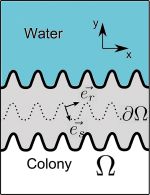EPJ E Highlight - Cells move as concentration shifts
- Details
- Published on 23 July 2013

Sheets of biological cells move along the organs they cover by altering the external concentrations of specific molecules, thanks to an absorption mechanism on the cells’ surface
What do wound healing, cancer metastasis, and bacteria colonies have in common? They all involve the collective displacement of biological cells. New research sheds some new light on the physical mechanisms provoking the displacement of a sheet of cell, known as an epithelium. It typically covers our organs including the stomach and intestine, as well as our epidermis. In a paper which appeared in EPJ E, Martine Ben Amar from Pierre and Marie Curie University in Paris explains the importance of understanding the displacement of the epithelium as a means of influencing the biological process involved in healing. And, ultimately, of helping to minimise scars.
In this study, Ben Amar aims at developing a predictive theoretical physics model based on calculations designed to account for experimental observations.
Her model focuses on particular types of displacement, which are due to molecules— referred to as morphogens—that the cells can feel. In fact, cells are sensitive to their concentration and are therefore attracted in their direction in a process called chemotaxis. Cells can also absorb these molecules at their surface as a means of modifying their concentration and therefore their displacement. In addition, the model takes into account physical parameters such as the substrate friction and the cohesion of the overall tissue.
Ben Amar found that her theory could be applied to better understand the irregularities found at the boundaries of the sheets, which are a signature of the collective behaviour of these cells, previously observed in recent in vitro biophysics experiments. Such irregularities could influence the quality of the future scar. This is important for the quality of vision in the case of cornea scars, and for a possible improvement in the bio-engineering of artificial tissues.
Chemotaxis migration and morphogenesis of living colonies. M. Ben Amar (2013), European Physical Journal E 36: 64, DOI 10.1140/epje/i2013-13064-5




